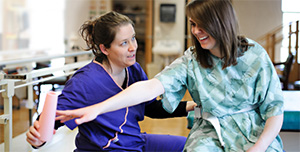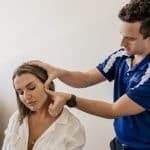Lung Physiotherapy

In Australia, during the end of winter and into the season of spring, people with respiratory and allergy problems suffer with an increase in their symptoms. Many find it difficult to breathe when they go outside when it is windy. In particular those in Melbourne may suffer from worsening of their symptoms because of the rye grass that blows around in the environment during the windy seasons of winter and spring.
For these reasons it may be necessary for you to find a treatment solution online. Telehealth consultations can be very effective in helping to treat some lung conditions. The physiotherapist may not be able to listen to your chest with a stethoscope, but when you’re positioned well in front of the computer camera it is possible to see the movement of your chest and where there may be problems.

Our team of physiotherapists are highly qualified in the treatment of lung and chest conditions. Our physiotherapists can teach you relaxed breathing exercises as well as basal expansion exercises, airway Clearance Techniques and how to cough effectively.
Our team of physiotherapists are highly qualified in the treatment of lung and chest conditions. Our physiotherapists can teach you relaxed breathing exercises as well as basal expansion exercises, airway Clearance Techniques and how to cough effectively.
Treatment techniques may include:
- Relaxed deep breathing
- Breathing into different parts of your lungs
- Increasing inspiratory volume
- Chest percussions and vibrations
- Postural drainage
- Reducing strain when coughing
- Teaching proper inhaler use
- Breathing and cardiovascular exercises
How is Physiotherapy used in Pulmonary Rehabilitation?
Physiotherapy is used in pulmonary rehabilitation to:
- help expand the lungs
- Relax the breathing
- Improve oxygenation
- Promote relaxation
- Improve pulmonary fitness
- Decrease severity of asthma and croup attacks
Respiratory conditions can sometimes lead to collapse of the lung tissues, particularly in the bases, so we would most likely see a decrease in movement of the belly and in the lower part of the lateral chest during inhalation. Shallow breathing that may be caused by collapse of the lower lobe lung tissue also results in overuse of the accessory muscles, which are the muscles in the neck and upper back. When breathing like this the shoulders elevate during the breath in and it is obvious that the muscles of the neck are being overused. We can clearly see this when this happens.
The other thing that we can notice is the sound of the breathing. We are able to hear whether there is some obstruction with the ‘in’ breath, the ‘out’ breath or if there is spasm in the airways leading to a wheezing sound. People with asthma and bronchitis can often have a wheeze. Depending on the sound of the breathing, we can work out whether there are secretions that need to be coughed up or whether the breathing pattern needs to be relaxed.
What are the long-term effects of COVID on the lungs, and how can physiotherapy help?
As the COVID pandemic continues and we learn more about the disease, it can be seen that even after you have recovered from the initial sickness, you can be left with long-term effects on your body, specifically your lungs.
COVID-19 can result in complications such as pneumonia, or in extreme cases ARDS or Acute Respiratory Distress Syndrome. Though these are extreme examples, it’s important to take care of your body and make sure you’re getting the treatment you need in order to recover from these conditions.
Respiratory physiotherapists will be able to assist you to recover and put a treatment plan in place to help you get back to breathing at your pre-Covid levels.
Can you still treat my lung condition via telehealth?
Yes, we can. Teaching effective expectoration techniques, such as coughing, can also help to move the secretions out of the lungs which will then help to improve the function of breathing and of course help with the oxygenation of the tissues.
Coughing can sometimes be a problem and cause irritation of the tissues in the airways. More specifically, coughing may result in this irritation when it becomes difficult to stop coughing. Excess coughing can actually cause you to develop the habit of excess coughing which then accentuates the problem, and can also lead to incontinence issues because of the increased abdominal pressure. Changing how you cough and teaching a “huffing” technique can help with this problem.
Huffing can help to move the secretions out of the airways more effectively and with less effort than coughing. If you are quite unwell with a respiratory condition you may have symptoms of lethargy and fatigue so it is important to be able to conserve as much energy as possible.
Other lung exercises such as blowing bubbles can be really effective and are easily taught via telehealth. Humidifiers, positive airway pressure devices and other instruments can also aid in the treatment and can easily be ordered online if necessary.
Correct breathing that helps to expand the lungs also may help to reduce and move the secretions in the lungs, and may help with the mobility of the lung tissue which may help with oxygen uptake. Effective breathing can also involve teaching how to breathe through your nose rather than your mouth. Breathing through the nose helps to warm the air which also helps to reduce spasm in the airways.
Different positions such as lying on your side or lying with a pillow under your waist may also help to drain the lungs and/or increase the air in the lungs, depending on your problem. Sometimes lying on your tummy or side will help to increase air into the bases of your lungs and sometimes breathing in standing or sitting is more effective. Percussion (clapping hands on the chest) can also help with some conditions and it is very easy to teach how to self percuss.
It is also very important to keep up some general exercise. Increasing the heart rate will in turn then increase the respiratory rate and help to aerate the lungs better. The oxygen uptake by the body is also increased by doing some general exercise.
Our physiotherapists are experienced in the management of respiratory conditions. We see patients both at home and in the clinic. We have all necessary Personal Protective Equipment (PPE) to protect you, ourselves and the rest of our patients.
Contact us today to book.


